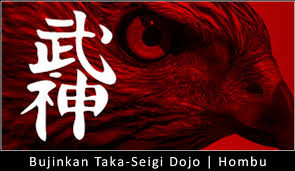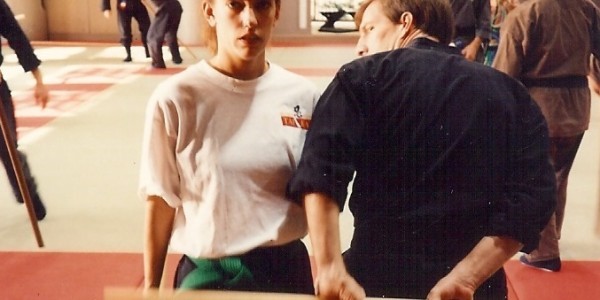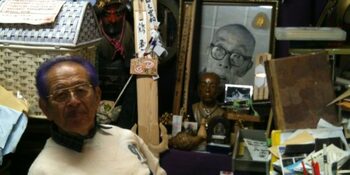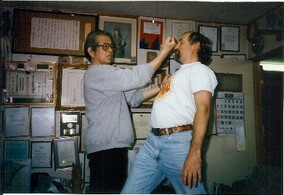
What Rank Should You Be to Train with Soke in Japan?
10.12.18

Joanne, training at Ayase as a green belt (93)and looking a bit bewildered, we can all probably relate to that !!
I get asked this question a LOT over the years. What rank do you think you should be in order to get the most out of your training in Japan? I imagine most Shidoshi and Shihan have their own answer to this question, that generally fall into three rank categories:
Option one: No specific rank required/needed. Rational: Training in Japan and especially with Soke is awe-inspiring! Anyone and everyone serious about Bujinkan training should go to Japan as soon as they are able to do so. Soke is getting older and may retire soon. Go ASAP.
Option two: After achieving the rank of Shodan. Rational: The rank of Shodan means you have a decent grasp of the basics and the student will be able to internalize some of the training and be inspired to train even harder when they return.
Option three: To take the Godan test. Rational: You have worked through the foundational levels of black belt (Shodan to Yondan) and are now ready to grasp what is beyond the basics. Being observed and tested in Japan will give the student some additional credibility with Soke and the Japanese Shihan. You will come back inspired and with a license to teach your own students, in your own dojo, and without as much over watch from your Shidoshi or Shihan.
Each of these options presented above have validity in and of themselves. Option one requires heavy support from the student’s instructor or dojo leaders to make sure the student finds the Hombu and is properly introduced to Soke and the Japanese Shihan. Although Soke is very happy and loose in his dojo, there is much proper Japanese etiquette and protocol to follow when training in Japan. The last thing an instructor wants to hear from Nagato Sensei is that their student went to Japan unprepared, did something out of line and brought discredit upon their instructor and dojo. New students accompanying their teacher on that first training trip will help the student gets the most out of their Japan experience. If the junior student speaks Japanese or has lived in Japan before (such as military stationed in Japan) and is comfortable moving around the country, that’s good. But it is still necessary for the student’s instructor to accompany them to make the introductions and ensure training protocols are met. If accompanying the teacher is not an option, then the Shidoshi/Shihan needs to write a letter of endorsement for the student. The letter should be written in Japanese so there is no misunderstanding. The letter can be mailed a month ahead of the student’s visit or the student can present it to Nagato Sensei or Soke at the first training session they attend. Finally, the student should be briefed that a number of the Japanese Shihan will recommend them for a higher Bujinkan rank while they are in Japan. This is to be expected, but there is a right way to accept the rank and a wrong way. If the Grandmaster himself gives the student a rank, then of course the student should accept it. If one of the Japanese Shihan recommends you for promotion, the student has two choices. If the student has been briefed by their instructor to accept any rank they receive in Japan, then accept it. If the student has been instructed not to accept a rank (maybe because they just got promoted in preparation for the trip), then the best thing to do is thank the Shihan for the recommendation and politely say that you will let your teacher know of the rank recommendation. The student’s teacher can then take care of the promotion after the student returns from Japan or advise the student to go ahead and submit it to Soke before departing. Of course the instructor could also say that the student needs more time to grow into that next rank. It’s best to clear all the rank protocol stuff up with students before they travel to Japan, whether accompanied by their teacher or not. Lastly, none of the gaijin living in Japan should have to be a new student’s crutch or goodwill case. I have seen time and time again, new students walk into Hombu and have no clue what to do, what to pay, were are the classes being held and when, what hotel to stay and how to get to all the training, etc. This creates and unnecessary burden on the gaijin that live in Japan. Shidoshi/Shihan, must properly prepare their students for the realities of visiting a foreign country and training in an arcane Budo art before launching them off on their first trip. And prepare them to be inspired!
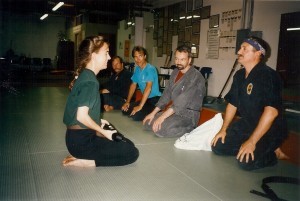
Joanne progressed though the art to make Shodan 4 years later (97)
What about the brand new Shodan? Much is the same is true for Shodan as it is for the newbie. The kanji for Shodan literally means, new beginning or new path. It means you have a solid grasp of the Taijutsu portion of our base of knowledge and some experience handling weapons and a few Henka. It is not the “be all” to “end all” of the students training. While Shodan represents a considerable amount of time in the dojo (in my own dojo’s case 2-4 years) they have many gaps in their training, especially with weapons and specific Ryu. The Shodan should have proper dojo etiquette down pat by now. They will have also heard stories of their Shidoshi/Shihan’s trips to Japan of the years they have been training. So they should be well indoctrinated in what happens in Japan with ranks and such. In the Shodan’s case it may not be as critical to accompany them over for their first training as it is with a newbie. However, its always-best if the Shidoshi/Shihan can do so. It just makes for a better trip all the way around, less opportunity for lapses in protocol and builds up a great instructor – student bond doing something together like that. The Shodan should also expect to be ranked and possibly ranked several times on their trip by different Shihan. The same holds true for Shodan as it does for a green belt. Accept it if Soke is the one giving you the rank (because he is the Soke of our art) and in the case of a Shihan recommendation, either accept or tell the Shihan you will advise your teacher of the recommendation as soon as you get back home. If your Shihan is standing there in the dojo, make sure you tell them right away so they can deal with the situation appropriately. This has happened a few times with my own students and I had zero problems going directly to the Japanese Shihan (and an American Shihan who knew I was this student’s teacher) and thanking them for their recommendation and I would give it due consideration. Each case is unique and should be valued as such. There is no standard answer that fits all students.

Joanne received her Judan (10th degree) menkyo 10 years later 2007
At the Yondan level, are you ready to go to Japan or what? Yondan in my dojo represents anywhere from 6-9 years of training. Yondan students should have a very good grasp of the Taijutsu base as well as strong fundamentals of all major weapons. They should be able to do henka of all the Kihon Happo and GoGyo, to include adding a weapon to either Tori or Uke. They should be ready physically, mentally and emotionally to take the Godan test. No Yondan should look at the test as a means to “fix” them in any way. The test is meant to light the way to your next path. If you are not yet ready to walk that path, the test will be for naught. Even if you manage to pass the test, there will be doubt and confusion and a sense of ‘loss of one’s place” in the dojo. Far too many times I have seen students in too big of a hurry to take the Godan test and it usually comes back to haunt them in some way. Taken too soon can ruin a once good relationship between teacher and student. As in the previous two examples, the Shidoshi/Shihan must prepare the student for what to expect from Soke and the Shihan at this critical juncture in their training. It used to be a common expression that after successfully passing the Godan test, “I have learned the basics and now Soke has given me a license to forget (the basics).” But I believe this is a misnomer. Sure we now have a license that says we can teach and it says we passed the Sakki test by tapping into something of the non-physical, but it does NOT give us license to stop training in and teaching the basics. Absolutely not. We must continue to polish and refine our basics for the rest of our training lives. For those of you who are at the Sandan-Yondan level now, I highly recommend you read an article I wrote a number of years ago about the Godan test at Soke’s request. It is called, “Don’t be in a Hurry.” You can FB me through our Taka Seigi page and I’ll send it to you or post it later. It has some valuable insights into the Godan test that has proven very helpful for students contemplating taking the test. Living in Japan for 4 years (from 03-07) as a 15th dan allowed me to give the test more than any other gaijin during that time period. I think you will find my observations very helpful.
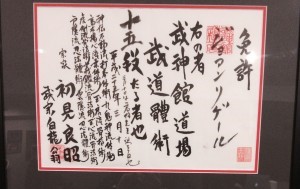
In 2014, Joanne was given her Jugodan. She has been training in the Bujinkan since 1993
Maybe by now you are wondering what I believe? My specific answer is that it depends on the student—that each student is unique and should be judged accordingly. My general answer is anytime you have an opportunity to go to Japan and train with Soke you should do it regardless of rank. Just make sure your Shidoshi/Shihan fully prepares you for the trip, both from an etiquette standpoint and dojo protocol. It’s always best if you can hold off a bit and accompany your teacher to Japan. This builds a lot of esprit de corps between you, your teacher and the other students along on the trip. We always have less time in life than we realize. Don’t hold off too long. Soke spoke at the Shidoshi-kai this year (January 2015) that he has now taught for the past 42 years since Takamatsu Soke’s passing. He feels that now that the Bujinkan has a few Dai-Shihan his promise to Takamatsu is complete. He has stated that he will step back from actively teaching and be in observer mode starting this year. So in this case, going to Japan, I suggest you do be in a hurry! In the end, it’s your call when to go. Hopefully this review of options will help to inform your decision.
Check out our member website for the latest in training from the senior-most Japanese Dai-Shihan, myself and other recognized seniors from around the world. Nagato Sensei and Noguchi Sensei are now giving me huge support for the website and we will be releasing a ton of their video training sessions over the course of the year. We just released video of both of these Dai-Shihan on our website last week that was captured during train last October. See for yourself why we are considered the very best Bujinkan Budo Taijutsu and Shinken Taijutsu reference website in the world.
As always I appreciate you comments and feedback. Cheers and best, Phil
